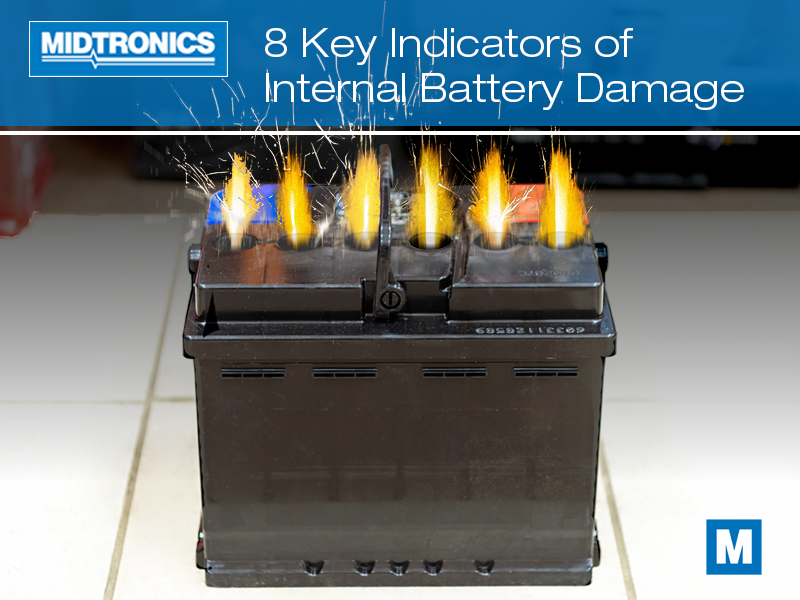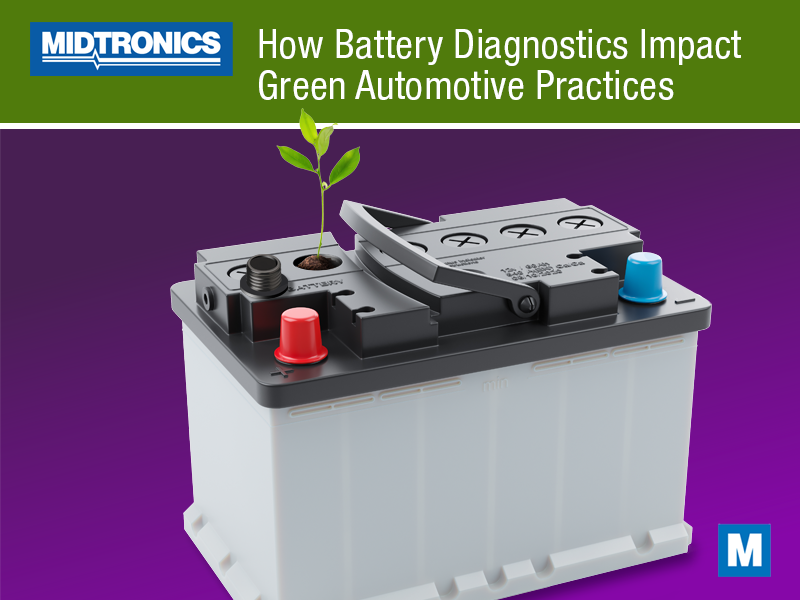In the world of automotive service and repair, battery diagnostics are essential. It’s true whether you’re working at a franchised dealership that sees mostly new cars coming in for routine maintenance and repairs, or older models frequenting an independent shop on the corner. Modern vehicles rely on advanced electronics and features, demanding reliable battery performance.
While external battery issues like corroded terminals are easy to spot, internal battery damage often goes unnoticed, leading to unexpected failures and frustrated customers. Understanding the key indicators of internal damage can help you diagnose problems early, improve customer satisfaction, and prevent repeat issues.
1. Unstable Voltage Readings
One of the most common signs of internal battery damage is inconsistent voltage. A healthy battery maintains stable voltage levels under load, but issues like sulfation or damaged plates cause unpredictable fluctuations.
To identify this, monitor voltage during a load test with your digital battery tester. Sharp drops or readings that are all over the place indicate internal resistance problems. These could stem from sulfation where lead sulfate crystals accumulate on the plates, or there could even be warped plates caused by overheating. Batteries showing unstable voltage should be replaced or diagnosed further as they’re at risk of failing when the demand gets heavier.
2. Rapid Discharge
A battery that loses charge unexpectedly fast is another sign of internal damage, often caused by an internal short circuit. Sediment from the lead plates can build up at the bottom of the battery, creating an unintended electrical pathway that drains energy even when the battery isn’t powering anything. It’s a normal occurrence from years of use, and usually several years more than the typical three-to-five-year lifespan.
This is common when customers complain about frequent jump-starts after their vehicle sits idle for a short period. Almost any battery test can confirm whether the battery is unable to hold a charge and needs replacement with modern testers like MVT being almost instantaneous to diagnose it.
3. Excessive Heat Build-Up
Although the temperature will increase slightly due to elevated kinetic energy during use, batteries aren’t supposed to get hot during normal operation. Excessive heat often points to internal resistance issues caused by damaged plates, or there’s a problem with the electrolyte level or mixture. When internal components degrade, the battery struggles to convert chemical energy into electrical energy efficiently, wasting energy as heat.
If the battery feels warm after charging or normal use, or if the case appears swollen and bulged, it indicates internal damage. A battery generating excessive heat should be replaced immediately to prevent thermal runaway, a dangerous situation that can lead to catastrophic failure.
4. Reduced Cranking Power
Reduced cranking power is a frequent complaint, especially on cold mornings. While external factors like corroded terminals or a weak starter motor can affect cranking power, internal issues are often the root cause. Damaged internal components reduce the battery’s cold cranking amps, limiting its ability to deliver power under load. Conducting a CCA test with a professional-grade tester can reveal if the battery isn’t living up to its ratings, although the better option is a comprehensive battery test. A seriously low CCA reading means the battery likely has internal damage and should be replaced.
5. Unusual Smells
A rotten egg smell coming from a battery is a clear indicator of damage inside the battery. This odor is caused by hydrogen sulfide gas that can escape during overcharging or if there’s internal breakdown. Issues like a cracked case, damaged cells, or overfilled electrolyte often cause this problem.
Batteries that put off unusual smells should be handled cautiously – hydrogen sulfide gas is toxic in high concentrations. Replacing the battery and checking the charging system for faults will help prevent future occurrences.
6. Visible Signs of Internal Damage
While most internal issues are hidden, some leave physical clues. Cracked or swollen battery cases are clear signs of internal pressure building beyond normal levels. Overcharging, extreme temperatures, or the internal components expanding often cause this visible damage. In cold-weather areas, it could be due to frozen electrolyte – a condition that only happens when a severely discharged battery is exposed to extreme cold.
During routine maintenance, inspect the battery case for swelling, cracks, or leaks. Deformed batteries should never remain in service since they pose risks to both the vehicle and the technician handling them.
7. Consistently Low State of Charge
A battery that consistently shows a low state of charge, even after being fully recharged, is another indicator of internal damage. This often points to deteriorated active material which prevents the battery from storing enough energy to support the car.
To confirm this, state of charge is analyzed by the tester after charging the battery. If the charge remains below 75%, the battery likely has internal issues and should be replaced.
8. Frequent Warning Light Triggers
Many modern vehicles come equipped with battery management systems that detect early signs of failure. A battery or charging system warning light on the dashboard is often a sign of internal battery faults. Failing batteries cause the alternator to overwork, triggering the warning light.
Running a comprehensive battery and charging system test can help pinpoint the problem. If the alternator is functioning properly but the battery shows signs of internal damage, replacing the battery is the best course of action.
How It Fits into Your Business
Internal battery damage can be challenging to identify, but catching the warning signs early is critical for keeping customers satisfied and preventing vehicle downtime. From unstable voltage readings to reduced cranking power, the indicators outlined here are important for diagnosing battery issues quickly and accurately.
Having the right tools is just as important as knowing what to look for. Advanced battery diagnostic equipment enables technicians to pinpoint internal problems with precision, helping service departments and repair shops deliver reliable solutions. At Midtronics, we provide industry-leading technology to help professionals stay ahead of battery failures. With the right tools and expertise, you’ll ensure your customers leave confident in their vehicle’s performance, keeping your business running smoothly.
Test often, replace when needed, and never underestimate the value of a healthy battery.




